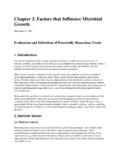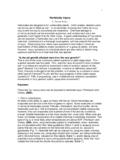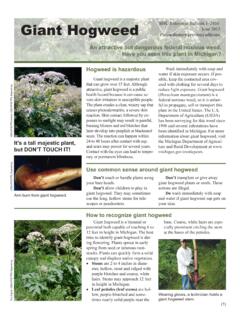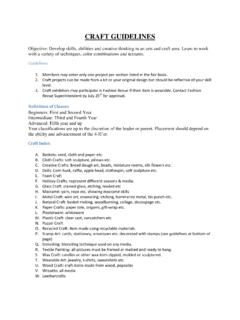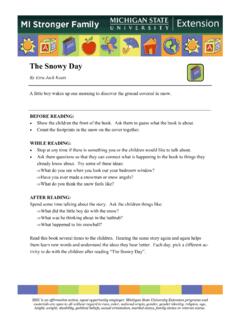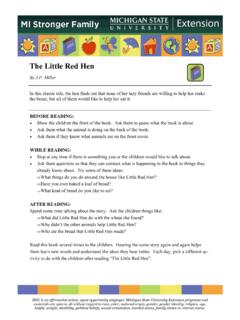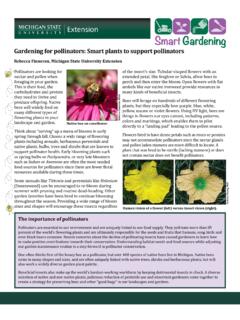Transcription of AN INTRODUCTION TO Interactive Theatre - MSU Extension
1 AN INTRODUCTION TO Interactive Theatre4-H YOUTH DEVELOPMENT | MICHIGAN STATE UNIVERSITY EXTENSION4H16082 YOUTH TAKE THE STAGE 4-H YOUTH DEVELOPMENT MICHIGAN STATE UNIVERSITY @ACKNOWLEDGMENTSA uthor Laura Gardner Salazar, , Theatre -Acting and Directing, University of Michigan Professor Emeritus and Founder of Grand Valley State University Theatre Program Past President, American Alliance for Theatre and Education Member, National Arts Education Standards Committee, 1990 2002 Project Coordinator Betsy M. Knox,Arts Program Leader, 4-H Youth Development Michigan State University ExtensionChild and Youth Development Specialist Christine Nelson, Educational Consultant Empire, MichiganEditors Beth Cheng, Editor, Poet and former 4-H Program Associate Michigan State University Extension Rebecca McKee, Editor Michigan State University Extension and ANR CommunicationsDesign Marian M.
2 Reiter, Graphic Artist Michigan State University Extension and ANR CommunicationsSilhouette artwork courtesy of Patricia Whitton Forrest, Editor and Publisher New Plays Inc. Charlottesville, Virginia Marquetta L. Frost, Case Manager Michigan Works! Youth Program and 4-H Volunteer, Calhoun County, Michigan Lisa Hodge Kander, Theatre Education, Wayne State University 4-H Volunteer Leader, Class Act 4-H Drama Club Oakland County, Michigan Kimberly Klaes, Teacher and Play Director Rockford Public Schools Rockford, MichiganMichigan Pilot SitesThe curriculum was piloted in Chippewa, Ingham, Jackson, Kent and Wexford counties. It also was used at several statewide Michigan 4-H volunteer workshops and at 4-H Exploration project is funded in part by donations from: Shirley M. Harbin, , Theatre Education, Wayne State University Faculty, Creative Drama and Children s Theatre , Wayne State University Past President, North American Regional Alliance of the International Amateur Theatre Association Norman & Marjory VeliquetteMichigan 4-H alumni, Antrim and Kent Counties 4-H Volunteers, Antrim CountyYouth Take the Stage: An INTRODUCTION to Interactive Theater.
3 Copyright 2010 by the Michigan State University Board of Trustees. These materials may be photocopied for purposes of 4-H programs and other nonprofit educational groups with full credit to MSU Extension . For information, contact 4-H Youth Development, Michigan State University Extension , 160 Agriculture Hall, East Lansing, MI is an affirmative action/equal opportunity employer. Michigan State University Extension programs and materials are open to all without regard to race, color, national origin, gender, gender identity, religion, age, height, weight, disability, political beliefs, sexual orientation, marital status, family status or veteran status. Issued in furtherance of MSU Extension work, acts of May 8 and June 30, 1914, in cooperation with the Department of Agriculture.
4 Thomas G. Coon, Director, MSU Extension , East Lansing, MI 48824. This information is for educational purposes only. Reference to commercial products or trade names does not imply endorsement by MSU Extension or bias against those not mentioned. The name 4-H and the emblem consisting of a four-leaf clover with stem and the H on each leaflet are protected under Title 18 707. 1P 06:2010 Web RM4-H YOUTH DEVELOPMENT MICHIGAN STATE UNIVERSITY YOUTH TAKE THE STAGE 3 Youth Take the Stage: An INTRODUCTION to Interactive Theatre @ CONTENTSA cknowledgments ..2 Youth Take the Stage: An INTRODUCTION to Interactive Theater ..4 Why Make the Theatre Interactive ? ..4 What Leaders Need to Know ..5 A Typical Interactive Theatre Performance.
5 5 Facilitation & Audience Interaction ..5 Forum Theater: A Form of Audience Interaction ..5 Before the Workshop ..6 Workshop Schedule ..6 Morning (2 to 3 hours) ..6 Afternoon (3 to 3 hours) ..7 After the Workshop ..7 The Community Connection & Researching an Issue ..8 Starting Out ..8 Youth Connecting With Their Communities ..9 Facilitating the Drama s Interaction ..9 What Does Facilitating a Drama Mean? ..9 Who Is a Facilitator? ..9 The Role of the Facilitator ..9 Characteristics of a Good Facilitator ..10 Behaviors of a Good Facilitator ..10 The Magic Solution ..10 Bringing Closure to the Drama ..11 Supporting the Audience ..11 Taking the Performance on the Road ..11 Identify Audiences & Performing Spaces ..11 Publicity & Marketing ..11 Budgeting, Fund-Raising & Record-Keeping.
6 12 Give After a Performance ..13 So, How d It Go? (Post-Performance Reflection) ..13 Reflection Questions ..14 Activities ..15-27 Becoming a Troupe Member ..15 Bubbling Emotions ..16 Combating Stage Fright ..18 Rights & Responsibilities ..19 Troupe Rights & Responsibilities [Handout] ..21 Tableaux Scene Building ..22 Tableaux Scenarios [Handout] ..24 Hot Seat Character & Imagined Props ..27 Glossary ..28 References ..304 YOUTH TAKE THE STAGE 4-H YOUTH DEVELOPMENT MICHIGAN STATE UNIVERSITY @Youth Take the Stage: An INTRODUCTION to Interactive TheatreThis one-day Interactive Theatre workshop includes about 6 hours of training and is designed primarily for adults who work with young people in out-of-school settings. No drama or Theatre experience is necessary to participate, just the desire to work with young people who want to perform and who want to make a difference on individual, community and global issues.
7 The workshop ideally is also conducted with 10 to 15 youth participants of similar ages (for example, young people in @Why Make the Theatre Interactive ?You ve just about said it all, Mr. Wilde! Theatre is a powerful and compelling way of showing what it s like to be human, because it tells stories about us how we see the world and how we see ourselves in the world. These stories show us conflicts that may be familiar or new to us, and we watch to see what happens to the characters as the action unfolds on Theatre is unique in that it is participatory. The audience not only watches, but becomes part of the production. In Interactive Theatre , the drama stops at a high point in the conflict when one or more characters have I regard the Theatre as the greatest of all art forms, the most immediate way in which a human being can share with another the sense of what it is to be a human being.)
8 Oscar Wilde, Irish poet, novelist, dramatist and critic, 1854 1900important decisions to make. Audience members are then invited to talk with the actors on stage. With the help of a facilitator who moderates this interaction, actors and audience members work together to devise positive ways to resolve the conflict. The actors then incorporate one or two of the audiences suggestions to resolve the conflict. Forum Theatre (see the sidebar on pg. 6) is a variation on Interactive Theatre in which an audience member replaces one actor on stage to act out audience suggestions. Either way the audience can see or experience firsthand how well their suggestions play 6 to 8 or grades 9 to 12).The training for the young people can end with this one-day workshop, or the workshop can be just the first step toward forming a performance troupe that takes the show on the road.
9 Such a troupe may perform for community groups, peers and younger Versus TheaterAmerican students usually are taught that theater is the American English spelling of the word and Theatre is its British English spelling. However, most American stage professionals and educators spell the word Theatre , rather than theater. This difference in spelling is intended to distinguish stage productions from those shown at a movie theater. Michigan State University s Department of Theatre uses the re ending, so this curriculum will, YOUTH DEVELOPMENT MICHIGAN STATE UNIVERSITY YOUTH TAKE THE STAGE 5@What Leaders Need to KnowA TYPICAL Interactive Theatre PERFORMANCEA typical Interactive Theatre performance runs from 35 to 45 minutes long. It may be set up something like this: The facilitator welcomes the audience and introduces the troupe, explains Interactive Theatre and the audience s role in the performance, and introduces the drama s issue.
10 (About 5 minutes) The troupe performs their prepared drama. (5 to 7 minutes) The facilitator leads the interaction between the audience and the actors, who stay in character on stage. (15 to 20 minutes) The facilitator brings closure to the performance by summarizing the main points raised by the interaction and by having the actors step out of character and introduce themselves by sharing information such as their first names, ages and schools. The facilitator thanks the audience for being part of the performance. If available, issue fact sheets are handed out to the audience. These sheets list important facts, resources and where to go for one-on-one support. (10 minutes)Through 4-H Interactive Theatre , young people can learn to perceive and make distinctions among the moods, intentions, motivations and feelings of others.
